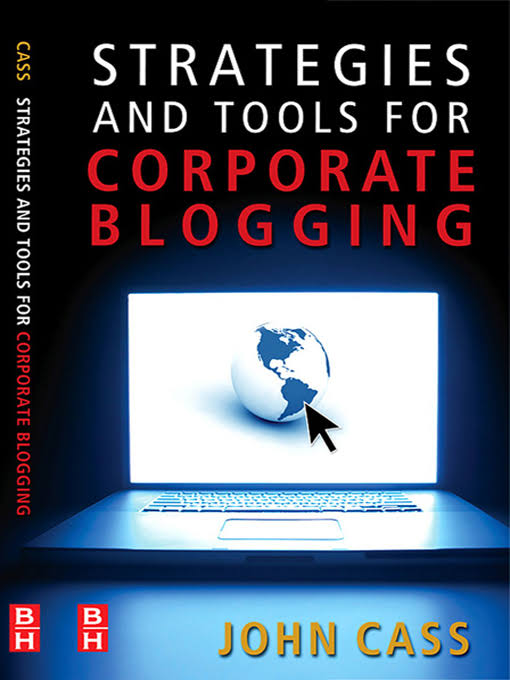Strategies and Tools for Business Blogging by John Cass

Business Blogging by John Cass
Mastering the Art of Corporate Blogging: A Deep Dive into John Cass’s “Strategies and Tools”
In today’s digitally saturated landscape, a robust online presence is no longer a luxury – it’s a survival tactic.
Businesses of all sizes leverage blogging to connect with their target audience, establish thought leadership, and drive brand awareness. But how do you ensure your corporate blog cuts through the noise and achieves real results?
John Cass’s “Strategies and Tools for Corporate Blogging” serves as a comprehensive roadmap for businesses looking to harness the power of blogging. This insightful guide delves into everything from crafting a winning content strategy to fostering meaningful relationships with bloggers and readers.
Let’s embark on a deeper exploration of the key takeaways from Cass’s book, unpacking how you can leverage them to cultivate a thriving corporate blog.

Understanding the Why: The Compelling Value Proposition of Corporate Blogging
Cass opens by highlighting the dramatic shift in communication dynamics. Traditional advertising and PR, while still valuable tools, no longer hold the monopoly on influencing consumer behavior.
Blogs empower businesses to engage in a two-way conversation with their audience, fostering trust, loyalty, and a sense of community.
Here are some of the compelling benefits of corporate blogging that Cass emphasizes:
- Thought Leadership: Position yourself as an industry authority by sharing valuable insights, expertise, and cutting-edge industry trends.
- Brand Awareness: Increase brand visibility by consistently creating content that resonates with your target audience.
- Lead Generation: Attract qualified leads by providing informative and engaging content that establishes you as a trusted resource. Potential customers actively seeking solutions will find you organically.
- Customer Engagement: Foster deeper connections with your customers by creating a space for open communication and feedback. Respond to comments, address concerns, and actively participate in discussions.
- Search Engine Optimization (SEO): Regularly updated, high-quality content can significantly improve your search engine ranking. This makes it easier for potential customers to find you online when they search for relevant keywords.
Building a Winning Blog Strategy: A Framework for Success
Before diving headfirst into content creation, Cass emphasizes the importance of developing a strategic framework for your blog. Here’s a closer look at some crucial steps outlined in the book:
- Target Audience Deep Dive: Who are you trying to reach with your blog? Understanding your ideal customer’s demographics, interests, pain points, and online behavior is essential for crafting content that resonates. Conduct market research, analyze competitor blogs, and utilize social media listening tools to gain valuable audience insights.
- Goal Setting and Measurement: What do you hope to achieve with your blog? Do you want to increase brand awareness by 20% within the next quarter, generate 100 qualified leads per month, or drive a specific percentage of sales through your blog content? Having clear goals will help you measure your success and tailor your content accordingly. Develop key performance indicators (KPIs) aligned with your goals to track progress and make data-driven decisions.
- Content Calendar Creation: Plan your blog posts in advance to ensure consistent content creation, maintain audience engagement, and avoid last-minute scrambles. Utilize content calendars to schedule posts, assign tasks, and collaborate with team members.
- Voice and Tone Development: What kind of personality do you want your blog to have? Informative and authoritative? Casual and conversational? Choosing the right voice and tone will help you connect with your audience on a deeper level. Consider the overall brand personality and how your blog voice aligns with it. Be consistent in your tone across all blog posts to build brand recognition.
Content is King: Crafting Compelling Blog Posts That Convert
Cass emphasizes that high-quality content remains the cornerstone of any successful blog. His book offers valuable guidance on creating blog posts that are informative, engaging, and optimized for search engines. Here are some key tips with additional insights:
- Focus on Value Proposition: Don’t just create content for the sake of content creation. Provide your audience with valuable information that solves their problems or addresses their pain points. Conduct keyword research to identify relevant search terms your target audience is using and incorporate them strategically throughout your content.
- Content Variety is Key: Experiment with different content formats to keep your audience engaged. Go beyond traditional blog posts and explore listicles, how-to guides, case studies, industry reports, white papers, infographics, explainer videos, and interviews with industry experts.
- SEO Optimization with a Human Touch: Integrate relevant keywords throughout your content to improve your search engine ranking. However, prioritize natural language and avoid keyword stuffing. Focus on creating informative and engaging content that readers will find valuable.
- Embrace Multimedia Storytelling: Incorporate high-quality images, infographics, and videos to enhance your content and make it more visually appealing, engaging, and informative.
Engaging Your Audience: The Power of Storytelling and Content Promotion
Cass emphasizes the importance of weaving storytelling into your blog content. People connect with stories on an emotional level, making them more likely to remember your message and take action.
Here are some effective ways to leverage storytelling in your corporate blog:
- Case Studies: Showcase real-world examples of how your products or services have helped customers achieve success.
- Customer Testimonials: Feature positive customer testimonials that highlight the benefits of your offerings.
- Data-Driven Narratives: Use data and statistics to tell compelling stories that paint a clear picture of industry trends and customer insights.
- Employee Spotlights: Highlight the expertise and human touch behind your brand by featuring employee profiles and interviews.
Once you’ve crafted compelling content, promoting it effectively is crucial for reaching your target audience. Cass outlines several strategies for content promotion:
- Social Media Marketing: Share your blog posts on relevant social media platforms and engage with your audience in the comments section. Utilize social media scheduling tools to streamline the process.
- Email Marketing: Include calls to action (CTAs) within your blog posts, encouraging readers to subscribe to your email list for additional content and updates. Promote your blog posts in your email marketing campaigns.
- Influencer Marketing: Partner with relevant industry influencers to promote your blog content to their audience.
- Paid Advertising: Consider paid advertising options on social media platforms or search engines to reach a wider audience.
The Art of Blogger Relations: Building Bridges and Expanding Reach
One of the most intriguing aspects of Cass’s book is his focus on blogger relations. He highlights the power of collaborating with established bloggers in your industry to reach a wider audience and leverage their credibility.
Here’s a deeper exploration of Cass’s strategies for building strong relationships with bloggers:
- Identify Relevant Bloggers: Research and identify bloggers who cater to your target audience and write about topics relevant to your niche. Utilize tools like Buzzsumo or Ahrefs to discover high-authority blogs in your industry.
- Develop Mutually Beneficial Relationships: Offer bloggers valuable content, early access to products, or interview opportunities in exchange for promotion on their platforms. Consider co-creating content with bloggers, leveraging their expertise and audience reach.
- Engage in Genuine Conversations: Don’t just approach bloggers with requests. Build relationships by commenting on their posts, participating in discussions on relevant forums, and offering constructive feedback.
Tools of the Trade: Resources for Successful Business Blogging
Cass recognizes the importance of having the right tools at your disposal. Beyond the tools mentioned earlier, here’s a look at some additional resources that can streamline the blogging process and enhance your content:
- SEO Optimization Tools: Tools like SEMrush or Ahrefs can help you identify relevant keywords, track your website’s search engine ranking, and analyze competitor strategies.
- Image Creation Tools: Tools like Canva or Adobe Spark offer user-friendly interfaces for creating high-quality images and infographics to enhance your blog posts.
- Analytics and Reporting Tools: Utilize website analytics tools like Google Analytics to track website traffic, user behavior, and key metrics associated with your blog content. Analyze data to understand what resonates with your audience and make data-driven decisions about future content strategy.
Final Word: Building a Sustainable Blogging Ecosystem
By implementing the strategies outlined in John Cass’s “Strategies and Tools for Corporate Blogging” and continuously refining your approach based on data and audience feedback, you can build a thriving corporate blog that delivers measurable results.
Remember, successful corporate blogging is a marathon, not a sprint. Stay committed to creating high-quality content, fostering genuine relationships with your audience and fellow industry professionals, and continually evolving your strategy to stay ahead of the curve.
Bonus Tip: Consider incorporating interactive elements like polls, quizzes, and surveys into your blog content to boost engagement and gather valuable audience insights.
This comprehensive exploration should provide you with a solid foundation for crafting a winning corporate blog strategy and leveraging its power to achieve your business goals.












